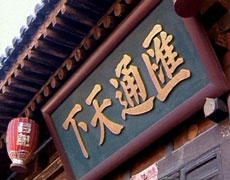Centuries of Regional Merchant Groups
In observing the development of Chinese merchant groups, it becomes apparent that no business group can exist without timely opportunities, the right conditions, and a beneficial geographical situation.
The splendor enjoyed by the Shanxi and Anhui merchants of old have become legendary. However,special circumstances, which blessed the beginning of China's reform and opening up, led to the unprecedented economic achievements of Guangdong's merchants, just as the outward-looking, multi-tiered market economy cultivated the success of Zhejiang's businesspeople.
 Shanxi bankers
Shanxi bankers

The Shanxi merchant group, from a region with a fair share of barren land, achieved commercial fame possibly even earlier than that of the Hui merchants. Their trading routes, more in the North-South direction, extended nationwide and reached Russia through the caravan land-routes. But what brought them unprecedented prosperity was their nationwide money remittance service from the 19th century.
Legend has it that it all started around the 1810s when a paint and dye merchant started China's first piaohao, a banking firm that provided merchants and long-distance travelers with drafts that they could exchange for cash at a specified branch after reaching their destination, thus effectively reducing the cost and risk of carrying bulky metallic cash.
By the mid-19th century, dozens of piaohao firms based in three Shanxi counties were setting up branch offices throughout major commercial cities in China, and turning, of all the places in China,Pingyao, a remote, little-known city, into the financial hub of a nationwide network of money remittance. After the turn of the century, they reached into Japan and Korea. Thus, for an entire century until the fall of the Qing in 1911, the Shanxi bankers had locked up the money transfer business in China.
 Hui merchants
Hui merchants
Huizhou's geographic location was significant to the economy of southeastern China as a communication hub between the south and the north. As a result of Huizhou's particular geographical condition and the need of economic development, landowners began to take up business.
In theSouthern Song Dynasty(1127-1279), as the capital was moved fromKaifengto Lin'an (now Hangahou), the political and economic center shifted to the south as well. This stimulated the economy of neighboring areas to develop, and introduced the Central Plains culture to the South.
